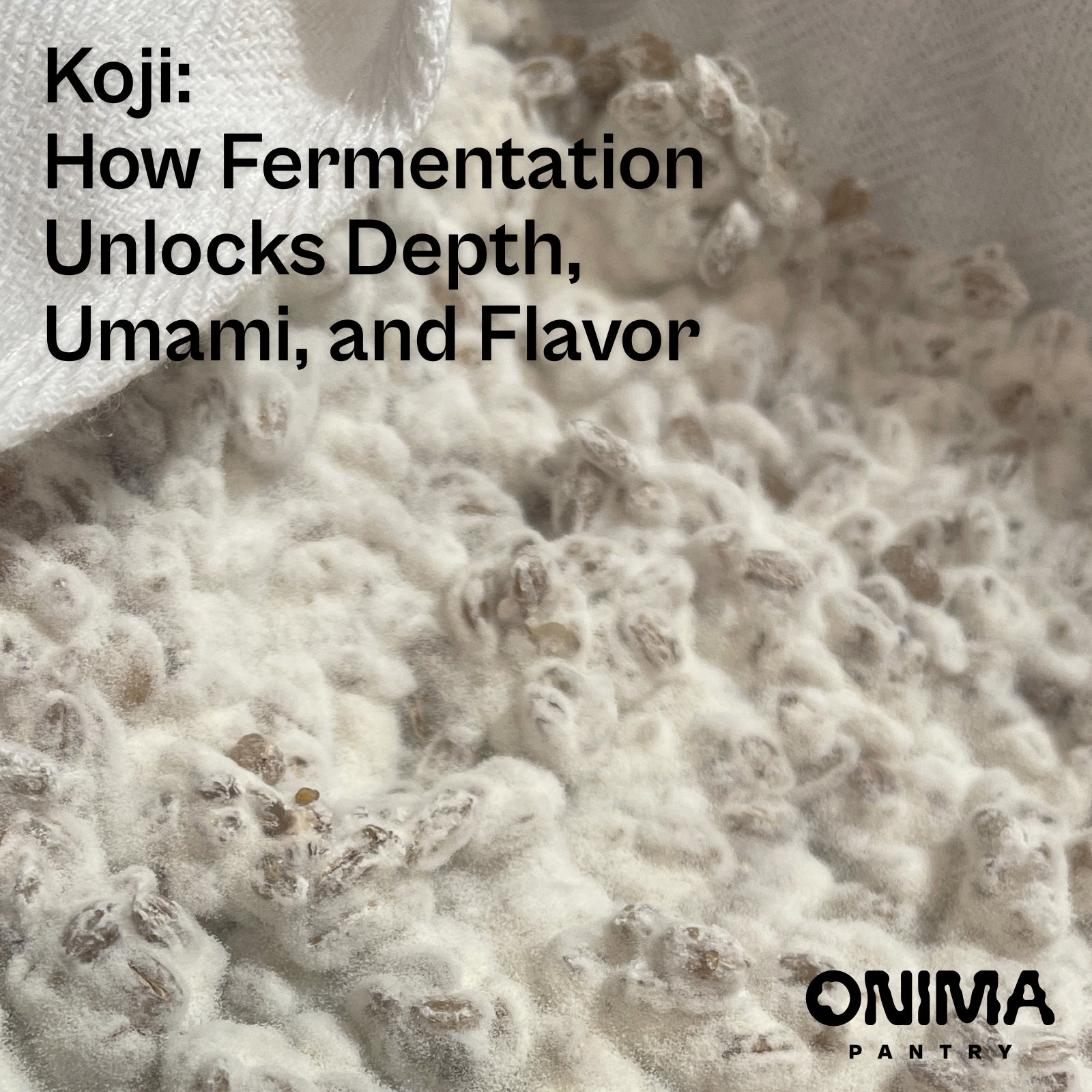Koji: How Fermentation Unlocks Depth, Umami, and Flavor
Published by ONIMA Pantry on
The world of nature presents us with countless wonders. When we delve into the depths of natural processes, one of the most fascinating discoveries is the remarkable ability of certain fungi to transform ordinary ingredients into something extraordinary. Among these transformations, the work of Aspergillus oryzae, commonly known as koji, stands out. Koji’s impact in the culinary world has only recently begun to gain recognition in the West, but its history and potential stretch back millennia.
Koji’s profound abilities make it a staple in the culinary practices of many cultures, especially in Japan. Whether used to create umami-rich ingredients like miso and soy sauce or as a secret weapon in the fermentation of meats and vegetables, koji’s applications are vast and varied. While koji may seem complex, its basic principles are rooted in nature’s simplicity.
What is Koji?
Koji is a unique form of mold—Aspergillus oryzae—that grows on grains like rice or barley. These grains are specially prepared and inoculated with the mold, creating a symbiotic environment where the mold can thrive. As it grows, the mold produces an intricate web of fungal cells known as hyphae. These hyphae penetrate the grains, digesting their starches, proteins, and fats through enzymes like amylase, protease, and lipase. These enzymes break down complex compounds into simple sugars, amino acids, and fatty acids, generating the characteristic sweet, savory, and umami-rich flavors associated with koji.
What begins as a simple process results in a cascade of chemical reactions that unlock flavors, aromas, and textures unseen in raw ingredients. Koji’s enzymatic activity is responsible for its magical transformation, turning something as ordinary as cooked rice into the foundation of complex, fermented products.
Koji’s Role in Fermentation
When talking about fermentation, koji is a cornerstone in unlocking the depth of flavors in many dishes. Its enzymatic breakdown doesn’t just produce sweetness; it also enhances umami—a key taste sensation that can elevate a dish. While many might be familiar with fermentation processes involving yeast or bacteria, koji stands apart as a mold that both creates flavor and supports the fermentation process of a broad range of ingredients.
From soy sauces to misos, koji plays a vital role in shaping the taste profiles of these products. Beyond traditional applications, it also enables rapid and efficient fermentation in modern culinary practices, enhancing flavors without requiring lengthy aging or intense heat.
The History of Koji in Culinary Traditions
Koji has a storied history in East Asia, particularly in Japan, where it has been used for over 1,000 years. Its earliest uses date back to ancient China, where it was discovered that certain molds could transform raw ingredients into fermented staples. Koji was introduced to Japan through cultural exchanges, and it became an integral part of the country's food culture. Its use in producing staple items like miso, soy sauce, sake, and amazake (a sweet rice drink) underscores its importance in daily Japanese life.
In Japan, the process of cultivating koji has been perfected over centuries. Master koji makers, known as tōji, carefully monitor the growth of the mold on grains to ensure the best results. The art of koji making is deeply intertwined with the Japanese concepts of precision and balance, which are fundamental to their culinary traditions.
Health Benefits of Koji
Apart from its culinary applications, koji offers significant health benefits. The fermentation process breaks down the food into easily digestible components, which can make it more suitable for people with digestive issues. Additionally, foods fermented with koji can be rich in probiotics, which support gut health and contribute to overall well-being.
Another key benefit is that koji-fermented products are often lower in sugar than their non-fermented counterparts, as the mold converts complex carbohydrates into simpler sugars. This makes koji-fermented foods an excellent choice for those looking to reduce their sugar intake while still enjoying sweet and savory flavors.
Koji is also a source of bioactive compounds that may have antioxidant and anti-inflammatory properties. These compounds can help fight oxidative stress in the body and support a healthy immune system.
Modern Applications of Koji
In recent years, koji has gained popularity outside of Japan, with chefs and food enthusiasts worldwide experimenting with its versatile properties. The rise of fermentation in Western kitchens has seen koji being used in innovative ways beyond its traditional applications. Chefs now use koji in new forms, such as seasoning meat for faster aging or making soy-free soy sauces. The culinary world is continuously discovering how koji can be a game-changer in various cuisines.
Some notable modern applications of koji include:
- Dry Aging Meats: By rubbing koji spores onto cuts of meat, the enzymes break down proteins, accelerating the aging process. This technique results in tender, flavorful meat in a fraction of the time traditional dry aging takes.
- Fermenting Vegetables: Koji can be used to ferment vegetables like cabbage, carrots, or beets, infusing them with umami flavors while maintaining their crispness. This expands the possibilities for plant-based ferments.
- Creating Vegan Condiments: As a mold that breaks down proteins and starches, koji is a perfect tool for developing vegan-friendly sauces and condiments that don’t rely on animal products but still deliver that signature savory depth.
How Koji Works: Enzymatic Powerhouse
The magic of koji lies in the enzymes it produces during its growth phase. These enzymes are biological catalysts that trigger chemical reactions in food. Among the most important enzymes are:
- Amylase: Breaks down starches into simple sugars, making grains sweet.
- Protease: Breaks down proteins into amino acids, contributing to umami.
- Lipase: Breaks down fats into fatty acids, adding richness to flavors.
Together, these enzymes dismantle the grains at a molecular level, unlocking their nutrients and producing a variety of flavor compounds. This process not only alters the grains themselves but also creates a foundation for secondary fermentation when koji is used in other processes, such as creating miso or soy sauce.
Koji’s Cultural and Historical Context
While koji has only recently made its way into Western kitchens, its origins go back thousands of years. In ancient Japan, koji was a revered ingredient, used by both the aristocracy and commoners to create essential food products. It was often cultivated on grains like barley, especially among peasants, while rice-based koji was favored by the upper classes. Today, koji remains a staple in Japanese fermentation techniques, often used to produce everything from sake to shoyu.
Koji’s versatility allowed it to evolve beyond its origins, and today it is used on various substrates beyond rice or barley. Chefs and culinary enthusiasts are experimenting with koji on different grains and even vegetables, pushing the boundaries of what it can do. Its power to break down complex compounds and produce deep, rich flavors is why it is seen as an indispensable tool in modern fermentation.
Koji at ONIMA Pantry
At ONIMA, we’re deeply inspired by the transformative powers of koji. IL MIG+ uses rice koji as one of its key ingredients, bringing a unique complexity that balances the heat of habanero peppers with savory, umami depth. We believe that fermentation is more than just a preservation technique — it’s a way to elevate flavors and create sauces that are layered, dynamic, and unforgettable.
Explore our other hot sauces on our shop page.

